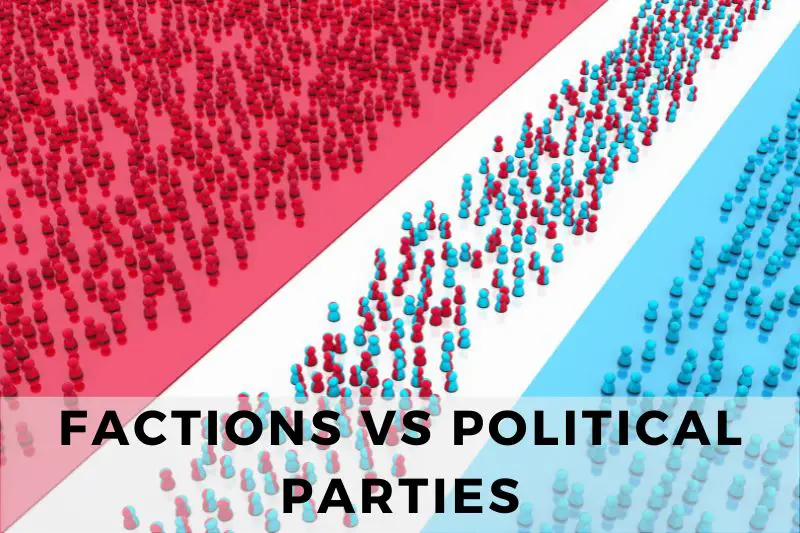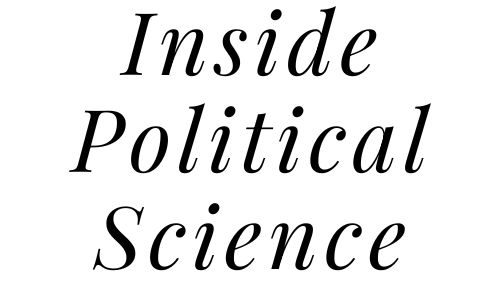
In 1787, James Madison warned that political factions could divide and weaken a nation. Today, both factions and parties shape politics, but they are not the same. Factions push specific agendas, often within larger parties. Political parties, however, seek broad support to win elections and govern.
The United States and the United Kingdom have seen both work together and clash. Understanding their differences helps explain political conflicts, shifting alliances, and the impact on governance. This article breaks down their definitions, structures, and influence, using historical and modern examples from the U.S. and U.K.
Definitions
Political Faction
A political faction is a smaller, organized group within a larger political entity that advocates for specific interests or policies. Unlike full-fledged political parties, factions do not seek independent electoral success but instead aim to influence decision-making from within. Factions often form around ideology, economic interests, or leadership disputes.
Historically, factions have played key roles in shaping political movements. In the U.S., the Federalists and Anti-Federalists emerged during the drafting of the Constitution, debating central government power. In the U.K., factions within the Conservative and Labour parties continue to shape policy directions. These groups influence party platforms and legislative priorities.
Political Party
A political party is an organized group that seeks to gain and maintain political power by running candidates in elections. Parties develop broad policy platforms to attract a diverse voter base, allowing them to govern effectively. Unlike factions, which focus on specific agendas, parties must appeal to a wider audience to remain competitive.
In the U.S., the Democratic and Republican parties dominate the political landscape, each representing a broad coalition of interests. In the U.K., the Labour and Conservative parties serve similar roles. These parties evolve over time, absorbing or rejecting factions based on shifting political climates and public opinion.
Key Differences Between Political Factions and Political Parties
#1. Formation and Structure
Political Factions arise within existing political parties or movements, often due to ideological disagreements, leadership disputes, or strategic differences. They may emerge informally as groups of like-minded politicians or activists who work together to push a specific agenda. Factions usually lack independent electoral infrastructure and rely on their host party for influence. However, if a faction becomes powerful enough, it may break away and form a new political party.
Political Parties are formally established organizations with legal recognition, leadership structures, and funding mechanisms. They register candidates for elections, campaign for public support, and seek to win political office. Parties develop official platforms, establish internal governance, and create hierarchies to manage operations at national, regional, and local levels. Unlike factions, parties are built for long-term political engagement rather than short-term policy battles.
#2. Scope and Purpose
Political Factions focus on specific policy goals, ideological principles, or leadership preferences. Their primary aim is to influence the direction of the broader political party they exist within. Factions may advocate for more conservative, progressive, nationalist, or libertarian positions, depending on their political environment. They do not typically seek direct control of the government but instead work to shift the party’s stance and priorities.
Political Parties have a broader purpose, seeking to gain electoral victories and implement wide-ranging policy agendas. They must balance various political interests to maintain widespread support. Because they need votes from different demographics, they often adopt moderate or compromise positions. While factions can afford to push for extreme policies, parties must remain electable and governable.
#3. Membership and Inclusion
Political Factions consist of individuals who align with a specific ideology or policy objective. Membership is often informal, as people can identify with multiple factions within the same party. Politicians may shift between factions based on political opportunities, public sentiment, or personal beliefs. Some factions form alliances with others within the party, while others operate independently.
Political Parties require formal membership and participation. They set rules for joining, voting in primaries, and holding leadership positions. A party’s success depends on recruiting and mobilizing a broad coalition of supporters, including ordinary voters, activists, and financial donors. Unlike factions, which may exclude those who do not strictly adhere to their ideology, parties aim for inclusivity to expand their voter base.
#4. Size and Influence
Political Factions are generally smaller than parties, but their influence can be significant. A well-organized faction can dictate a party’s policy direction, shape candidate selection, and even determine legislative priorities. The power of a faction depends on how effectively it mobilizes support within the party, how much public backing it has, and whether it can negotiate with party leadership.
Political Parties have a much larger base, encompassing millions of voters, donors, and elected officials. Their influence extends beyond shaping internal policies to controlling legislative and executive functions. Unlike factions, which operate within party limits, parties can directly govern, pass laws, and make executive decisions. The ability to field candidates and win elections gives parties an institutional advantage over factions.
#5. Stability and Organization
Political Factions can be fluid, forming and dissolving based on political shifts. Some factions last only for a single election cycle, while others persist for decades. If a faction becomes dissatisfied with the direction of its party, it may either fade away, form a new party, or attempt to take over the existing party from within.
Political Parties are structured for long-term political engagement. They invest in organizational infrastructure, including campaign offices, fundraising networks, and grassroots mobilization efforts. While parties evolve over time, they generally remain stable institutions, adapting to changing political landscapes rather than disappearing outright. Even when a party experiences internal conflicts, it is more likely to restructure than dissolve.
#6. Role in the Political Process
Political Factions operate within existing parties, influencing policy debates, leadership decisions, and legislative priorities. They act as pressure groups within a party, advocating for specific policies and attempting to sway decision-makers. Factions may challenge party leadership, push for internal reforms, or align with other factions to gain influence. However, they do not typically run independent election campaigns or seek direct control over government institutions.
Political Parties participate directly in the political process by nominating candidates, organizing campaigns, and competing in elections. Their goal is to win seats in legislatures, control executive offices, and implement policy agendas. Unlike factions, which may focus on single issues, parties must govern across a wide range of policy areas. Winning elections and maintaining public support require strategic decision-making and coalition-building beyond factional concerns.
#7. Examples
Political Factions can be found in both historical and modern politics. In the U.S., the Tea Party Movement emerged as a right-wing faction within the Republican Party, advocating for limited government and tax cuts. Similarly, the Progressive Caucus within the Democratic Party promotes left-wing policies like universal healthcare and wealth redistribution. In the U.K., the European Research Group (ERG) is a faction within the Conservative Party, pushing for hardline Brexit policies, while the Momentum Movement within Labour has pushed for socialist policies.
Political Parties are broader organizations with distinct electoral and governing ambitions. In the U.S., the Democratic Party and Republican Party dominate the political landscape, each containing multiple factions within them. In the U.K., the Conservative Party and Labour Party function similarly, representing broad ideological coalitions. Unlike factions, these parties contest elections at all levels, from local councils to national government.
#8. Internal Conflicts and Cooperation
Political Factions often create internal divisions within their parent party. Rival factions may compete for control, leading to leadership challenges, policy shifts, or even party splits. However, factions can also cooperate with each other when their interests align. For example, moderate and progressive factions within the Democratic Party have clashed over economic policies but have united against Republican opposition in key elections.
Political Parties must manage factional conflicts to maintain unity and electoral viability. While internal disagreements can weaken a party, successful parties find ways to integrate factional interests into broader coalitions. Party leaders often act as mediators, balancing competing viewpoints to prevent fragmentation. In some cases, parties adjust their platforms to accommodate factional demands, ensuring long-term stability.
#9. Adaptability and Evolution
Political Factions are highly adaptable, forming in response to political events, social movements, or shifts in public opinion. They can evolve rapidly, gaining or losing influence based on political circumstances. Some factions disappear when their goals are achieved, while others transform into lasting movements. For example, the Tea Party’s influence declined as its ideas were absorbed into mainstream Republican politics.
Political Parties evolve at a slower pace due to their institutional structures and need for electoral stability. While parties adjust their policies over time, they generally maintain core ideological principles to retain voter loyalty. Major shifts in party identity—such as the U.S. Democratic Party’s realignment on civil rights in the 20th century—occur gradually and often in response to societal changes rather than short-term factional pressures.
#10. Impact on Democracy and Governance
Political Factions contribute to democratic debate by introducing diverse viewpoints and pushing for policy innovation. They ensure that minority opinions within a party are represented and can challenge party leadership to remain responsive to its base. However, intense factionalism can also lead to internal gridlock, preventing effective decision-making. If factions become too divided, they may weaken their parent party’s ability to govern.
Political Parties play a fundamental role in democratic governance by organizing political competition and ensuring government stability. Strong parties provide voters with clear choices, enabling functional policymaking and governance. However, when parties become too rigid or dominated by one faction, they may struggle to adapt to changing public needs, leading to political stagnation or voter dissatisfaction. Balancing factional interests within a party is crucial for long-term democratic success.
Closing Thoughts
Political factions and political parties are interconnected but distinct forces in politics. Factions push specific agendas within larger parties, shaping policy debates and leadership decisions. Parties, on the other hand, must build broad coalitions to win elections and govern effectively.
Both play vital roles in democracy, but too much factionalism can create instability, while overly rigid parties can become unresponsive to change. Understanding the differences between factions and parties helps explain political conflicts, shifting alliances, and the challenges of governance. Whether in the U.S. or U.K., the balance between these two forces continues to shape political landscapes.
